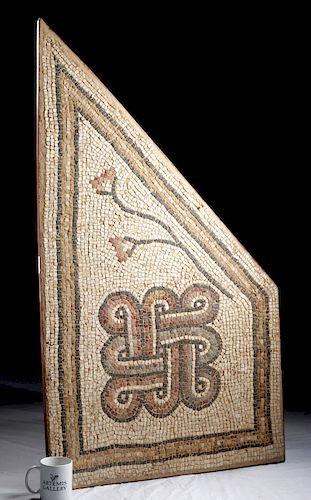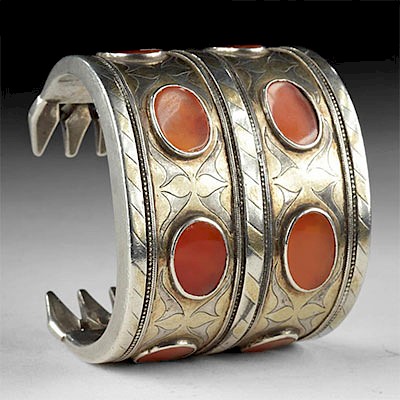Late Roman / Early Christian Mosaic w/ Knot & Flower
Lot 43b
About Seller
Artemis Fine Arts
686 S Taylor Ave, Ste 106
Louisville, CO 80027
United States
Selling antiquities, ancient and ethnographic art online since 1993, Artemis Gallery specializes in Classical Antiquities (Egyptian, Greek, Roman, Near Eastern), Asian, Pre-Columbian, African / Tribal / Oceanographic art. Our extensive inventory includes pottery, stone, metal, wood, glass and textil...Read more
Estimate:
$10,000 - $15,000
Absentee vs Live bid
Two ways to bid:
- Leave a max absentee bid and the platform will bid on your behalf up to your maximum bid during the live auction.
- Bid live during the auction and your bids will be submitted real-time to the auctioneer.
Bid Increments
| Price | Bid Increment |
|---|---|
| $0 | $25 |
| $300 | $50 |
| $1,000 | $100 |
| $2,000 | $250 |
| $5,000 | $500 |
| $10,000 | $1,000 |
| $20,000 | $2,500 |
| $50,000 | $5,000 |
| $100,000 | $10,000 |
| $200,000 | $20,000 |
About Auction
By Artemis Fine Arts
Aug 6, 2019
Set Reminder
2019-08-06 11:00:00
2019-08-06 11:00:00
America/New_York
Bidsquare
Bidsquare : VARIETY SALE | Antiquities & Ethnographic Art
https://www.bidsquare.com/auctions/artemis-gallery/variety-sale-antiquities-ethnographic-art-4326
Around the world & back in time - be amazed at the treasures you will find. Antiquities from Egypt, Greece, Italy and the Near East, Asian, Pre-Columbian, African / Tribal / Oceanic, Native American, Spanish Colonial, Russian Icons, Fine Art, much more! All categories, all price ranges... Artemis Fine Arts info@artemisgallery.com
Around the world & back in time - be amazed at the treasures you will find. Antiquities from Egypt, Greece, Italy and the Near East, Asian, Pre-Columbian, African / Tribal / Oceanic, Native American, Spanish Colonial, Russian Icons, Fine Art, much more! All categories, all price ranges... Artemis Fine Arts info@artemisgallery.com
- Lot Description
Late Roman to Early Christian, ca. late 4th to 5th century CE. A fine stone mosaic created from hundreds of square stone tesserae presenting a composition featuring a complex knot - perhaps an interlacing rainbow or a variant of Solomon's knot (Latin term: sigillum Salomonis meaning Seal of Solomon) with a flowering branch above, surrounded by a generous border, all delineated in a beautiful color palette comprised of rose, burgundy, gold, grey, and black hues against a white ground. The trapezoidal shape is very intriguing as well, and suggests that it was pendant with another or others to an octagon or hexagonal design in a floor. See notes from Professor Kilinski below which discuss this design further. Size: 48.75" W x 28.25" H (123.8 cm x 71.8 cm)
This piece comes with a letter written by Dr. Karl Kilinski II, Classical Archaeologist and Art Historian of Southern Methodist University. According to Professor Kilinski, "The trapezoidal shape of this mosaic indicates that it was probably matched by another, in mirror like fashion, if not three others, which all were appended to an octagonal or perhaps hexagonal design in the floor. The interlacing ribbon of many colors was used as an isolated, self-contained pattern … or as part of more complex geometric designs to cover an entire floor … In the case of this mosaic the former situation is more applicable; the mosaicist feeling compelled to include the double-budded flower stem in order to fill the tapering space of the trapezoid."
Dr. Kilinski continues, "The transition from Late Antique to Early Christian mosaics introduces a shift in emphasis from thematic narrative to symbolic interpretation; this is no less apparent in the East Mediterranean, in only somewhat later, than in North Africa and the West. The interlacing rainbow motif, once nothing more than a creative ornamental design in a multitude of Greco-Roman geometric patterns, takes on new meaning on the floors of Early Christian churches. With no apparent beginning and without end its intertwining form represents eternity; the simple flower surely represents life and peace."
Another possible interpretation of the interlacing form is that it is a Solomon's knot variant. The Solomon's knot is named for the biblical monarch Solomon who was known for his wisdom. In the study of ancient mosaics, the Solomon‘s knot is also known as a "guilloche knot' or a "duplex knot", and a Solomon's knot positioned at the center of four curving arcs is called a "pelta–swastika" (pelta being Latin for shield). The Solomon’s Knot symbol has also been found at the Byzantine Monastery at Kursi National Park. It seems that the three main monotheistic religions adopted the symbol. Two different versions of Solomon‘s knot were revealed in the recently excavated Yattir Mosaic in Jordan. The symbol has also been found woven into an antique Central Asian prayer rug. To the west, one can find Solomon‘s knot in Moorish Spain, and the British Museum has a 14th century Egyptian Koran with a Solomon’s Knot on the frontispiece.
A copy of Dr. Kilinski's letter discussed above - written to Civilization Gallery, Dallas and dated June 28, 1990 - will accompany this piece.
Provenance: private Dallas, Texas, USA collection; acquired at Civilization Gallery, Dallas, Texas in 1990s; Dr. Kilinski authenticated mosaics for this gallery, and a copy of Dr. Kilinski's letter discussed above - written to Civilization Gallery, Dallas and dated June 28, 1990 - will accompany this piece.
All items legal to buy/sell under U.S. Statute covering cultural patrimony Code 2600, CHAPTER 14, and are guaranteed to be as described or your money back.
A Certificate of Authenticity will accompany all winning bids.
We ship worldwide and handle all shipping in-house for your convenience.
#146676Expected old chips to some tesserae. Areas of mineral deposits as shown. Set in a modern plaster matrix with a metal frame that has been painted russet red. Some cracks/losses to verso of matrix; however, these do not appear to compromise the mosaic.Condition
- Shipping Info
-
All shipping is handled in-house for your convenience. Your invoice from Artemis Gallery will include shipping calculation instructions. If in doubt, please inquire BEFORE bidding for estimated shipping costs for individual items.
-
- Buyer's Premium



 EUR
EUR CAD
CAD AUD
AUD GBP
GBP MXN
MXN HKD
HKD CNY
CNY MYR
MYR SEK
SEK SGD
SGD CHF
CHF THB
THB
















